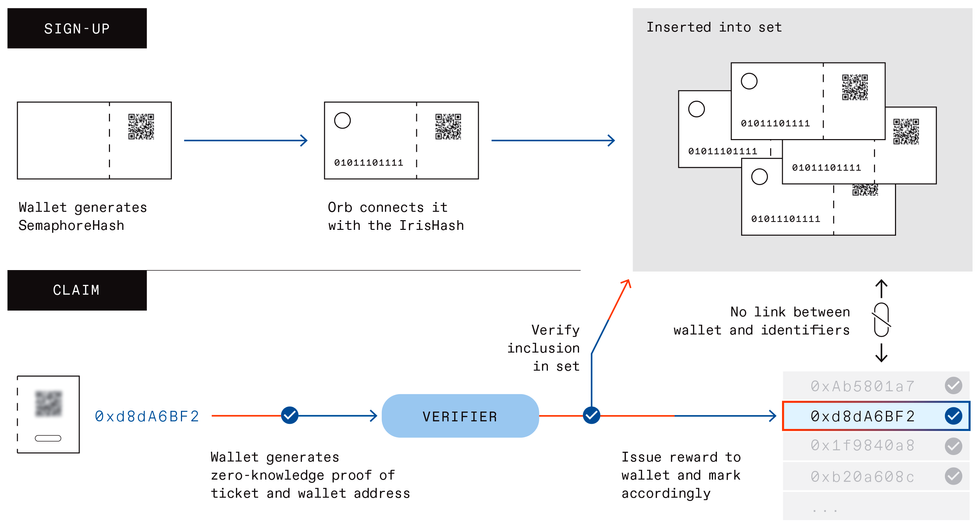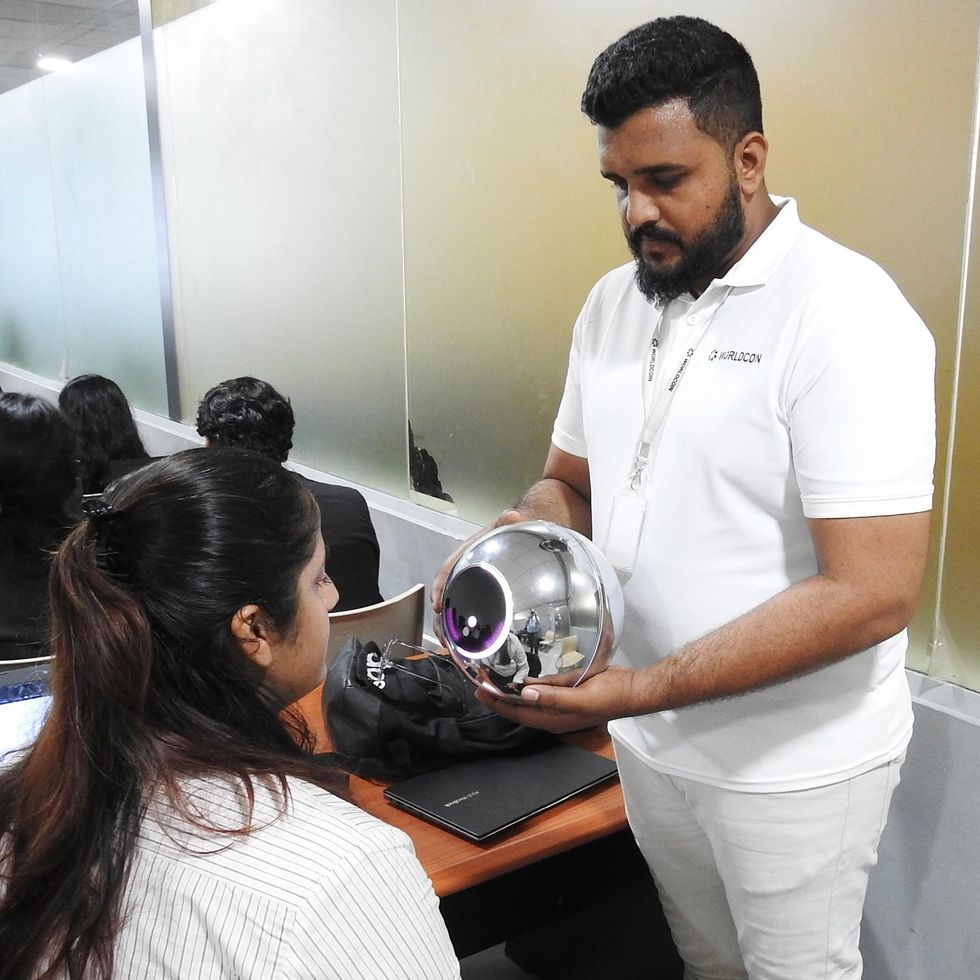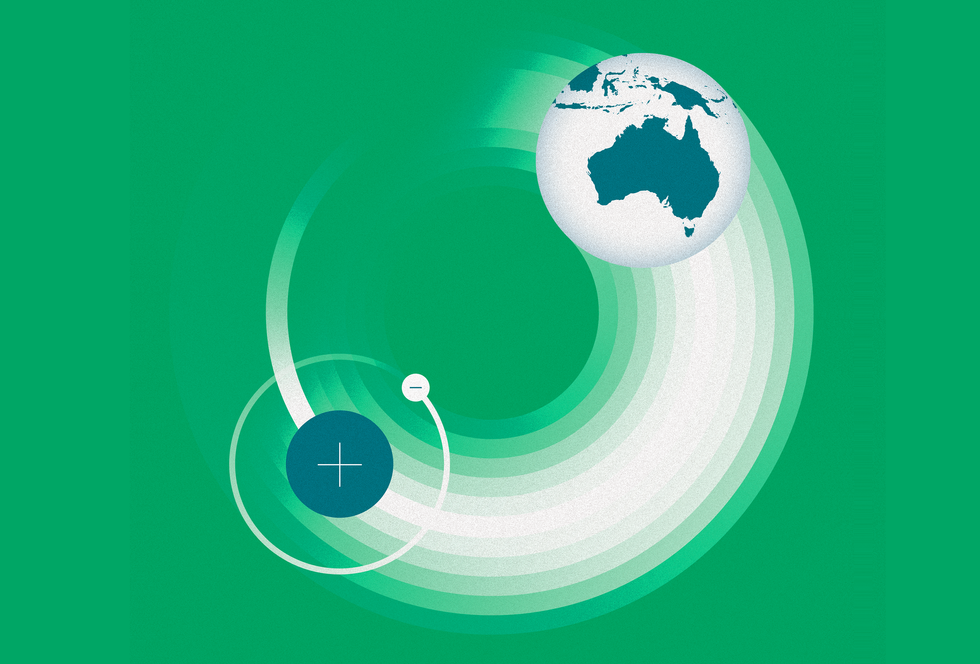Is Worldcoin a Crypto-currency for the Masses or Your Digital ID?
The project aims to scan all the world’s eyeballs

People queue up to have their irises scanned at an outdoor sign-up event for Worldcoin in Indonesia.
In a college classroom in the Indian city of Bangalore last August, Moiz Ahmed held up a volleyball-size chrome globe with a glass-covered opening at its center. Ahmed explained to the students that if they had their irises scanned with the device, known as the Orb, they would be rewarded with 25 Worldcoins, a soon-to-be released cryptocurrency. The scan, he said, was to make sure they hadn’t signed up before. That’s because Worldcoin, the company behind the project, wants to create the most widely and evenly distributed cryptocurrency ever by giving every person on the planet the same small allocation of coins.
Some listeners were enthusiastic, considering the meteoric rise in value that cryptocurrencies like Bitcoin since they launched. “I found it to be a very unique opportunity,” said Diksha Rustagi. “You can probably earn a lot from Worldcoin in the future.” Others were more cautious, including a woman who goes by Chaitra R, who hung at the back of the classroom as her fellow students signed up. “I have a lot of doubts,” she said. “We would like to know how it’s going to help us.”
This article is part of our special report Top Tech 2023.
Those doubts may be warranted. The 5-minute pitch from Ahmed, a contractor hired to recruit users, focused on Worldcoin’s potential as a digital currency, but the project’s goals have morphed considerably since its inception. Over the past year, the company has developed a system for third parties to leverage its massive registry of “unique humans” for a host of identity-focused applications.
Worldcoin CEO Alex Blania says the company’s technology could solve one of the Web’s thorniest problems—how to prevent fake identities from distorting online activity, without compromising people’s privacy. Potential applications include tackling fake profiles on social media, distributing a global universal basic income (UBI), and empowering new forms of digital democracy.

But Worldcoin’s biometric-centered approach is facing considerable pushback. The nature of its technology and the lack of clarity about how it will be used are fueling concerns around privacy, security, and transparency. Questions are also being raised over whether Worldcoin’s products can live up to its ambitious goals.
So far, Worldcoin has signed up more than 700,000 users in some 25 countries, including Chile, France, and Kenya. In 2023 it plans to fully launch the project and hopes to scale up its user base rapidly. Many people will be watching the company during this make-or-break year to see how these events will unfold. Will Worldcoin succeed in reimagining digital identity, or will it collapse, like so many buzzy cryptocurrencies that have come before?
Where the Worldcoin idea came from
In early 2020, Blania started working with Worldcoin cofounders Sam Altman, former president of the legendary Silicon Valley incubator Y Combinator, and Max Novendstern, who previously worked at the financial-technology company Wave. The question driving them was a simple one, Blania says. What would happen if they gave every person on the planet an equal share of a new cryptocurrency?
Their thesis was that the network effects would make the coin far more useful than previous cryptocurrencies—the more people who hold it, the easier it would be to send and receive payments with it. It could also boost financial inclusion for millions around the world without access to traditional banking, says Blania. And, if the coins increase in value (as have other cryptocurrencies like Bitcoin and Ethereum), that trend could help redistribute global wealth.
Most ambitiously, the founders envisaged Worldcoin as a global distribution network for UBI—a radical approach to social welfare in which every citizen receives regular cash payments to cover their basic needs. The idea has become popular in Silicon Valley as an antidote to the job-destroying effects of automation, and it has been tried out in locations including California, Finland, and Kenya. When the Worldcoin project was unveiled in October 2021, Altman told Wired that the coin could one day be used to fairly distribute the enormous profits generated by advanced artificial intelligence systems.
The founders envisaged Worldcoin as a global distribution network for universal basic income.
To ensure even distribution of coins, Worldcoin needed a sign-up process that guaranteed that each person could register only once. Blania says the team didn’t want to tie the cryptocurrency to government IDs due to privacy risks, and they eventually decided that only biometric iris scans could scale into the billions. Given the sensitivity of biometric data, the team knew that privacy protections had to be paramount. Their solution is a protocol based on Proof-of-Personhood (PoP)—a complex combination of custom hardware, machine learning, cryptography, and blockchain technology that Blania says can assign everyone a unique digital identity with complete anonymity.
The Orb is central to this approach. Behind its gleaming surface is a custom optical system that captures high-definition iris scans. To sign up for Worldcoin, enrollees download the company’s app onto their smartphones, where it creates a pair of linked cryptographic keys: a shareable public key and a private key that remains hidden on the user’s device. The public key is used to generate a QR code that the Orb reads before scanning users’ irises. The company says it has invested considerable effort into making Orbs resistant to spoofing sign-ups with modified or fake irises.
The scan is then converted into a string of numbers known as a hash via a one-way function, which makes it nearly impossible to re-create the image even if the hash is compromised. The Orb sends the iris hash and a hash of the user’s public key to Worldcoin’s servers in a signed message. The system checks the iris hash against a database to see if the person has signed up before, and if not, it’s added to the list. The public-key hash is added to a registry on the company’s blockchain.
The process for claiming the user’s free Worldcoins relies on a cryptographic technique known as a zero-knowledge proof (ZKP), which lets a user prove knowledge of a secret without revealing it. The app’s wallet uses an open-source protocol to generate a ZKP showing that the holder’s private key is linked to a public-key hash on the blockchain, without revealing which one. That way, Worldcoin won’t know which public key is associated with which wallet address. Once this linkage is verified by the company’s servers, the tokens are sent to the wallet. The ZKP also includes a string of numbers unique to each user called a nullifier, which shows if they’ve tried to claim their coins before without revealing their identity.
Worldcoin’s Web3 applications
It didn’t take long for Worldcoin to realize that its identity system could have broader applications. According to Blania, the first to spot the potential was Chris Dixon, a partner at the venture capital firm Andreessen Horowitz, which led the first investment round in Worldcoin. Blania says that about seven months after the team started work on the project, he told them, “This is super interesting tech, but I think you don’t understand what a big deal it actually is.”
On today’s Internet, most activities flow through centralized platforms like Amazon, Facebook, and PayPal. Blockchain technology could theory remove these middlemen, instead using a decentralized networks of volunteers to regulate such functions as online payments, social media, ride-sharing platforms, and many other types of services—a vision for the future of the Internet dubbed Web3.
Worldcoin’s biggest challenge may not be the functionality of its technology, but questions of trust.
But decentralization also enables new kinds of manipulation, including sybil attacks, named after the 1973 book Sybil, about a woman with multiple personalities. The anonymity of the Internet means it’s easy to create multiple identities that let attackers gain disproportionate influence over decentralized networks. That’s why cryptocurrencies today require members to carry out complex mathematical puzzles or stake large chunks of their money if they want to contribute to core activities like verifying transactions. But that means control of these networks often boils down to how many high-powered computer chips you can afford or how much crypto you hold.

A method to ensure that every member of a network has just one identity could solve the sybil problem in a much more equitable way. And a unique digital ID could have applications beyond Web3, says Tiago Sada, head of product at Worldcoin, such as preventing bot armies on social media, replacing credit-card or government-ID verification to access online services, or even facilitating democratic governance over the Web. Toward the end of last year, Sada says, Worldcoin started work on a new product called World ID—a software-development kit that lets third parties accept ZKPs of “unique humanness” from Worldcoin users.
“A widely adopted PoP changes the nature of the Internet completely,” says Sada. “Once you have sybil resistance, this idea of a unique person [on a blockchain], then it just gives you an order of magnitude more things you can do.”
Worldcoin’s pivot to World ID
Despite the startup’s growing focus on World ID, Blania insists its ambitions for the Worldcoin cryptocurrency haven’t diminished. “There is no token that has more than 100 million users,” he says. Worldcoin could have billions. “And really no one knows what the explosion of innovation will be if that actually happens.”
But the coin has yet to be released—those who sign up get an IOU, not actual cryptocurrency—and the company has released few details on how it will work. “They haven’t shared anything regarding what their currency model or their economic model is going to be,” says Anna Stone, who leads commercial strategy for a nonprofit called Good Dollar. “It’s just not yet clear how individual users will benefit.”
Good Dollar distributes small amounts of its own cryptocurrency to anyone who signs up, as a form of UBI. Stone says the project has focused on creating a sustainable stream of UBI for claimants, while Worldcoin seems to be committing far more resources to developing its PoP protocol than the currency itself. “Offering people free crypto is a powerful lead-generation tactic,” she says. “But getting people into your system and getting people using your currency as a currency are two quite different challenges.”
“It’s really hard to revoke and reissue your iris.” – Jon Callas
Leading UBI proponent Karl Widerquist, a professor of philosophy at Georgetown University–Qatar, says he’s skeptical of the potential of cryptocurrencies for boosting financial inclusion or enabling UBI. He says their inherently volatile prices make them unsuitable as currency. But Worldcoin’s one-time distribution seems even less likely to succeed, he says, because most people around the world are so poor that they spend everything they have right away. “The majority of people in the world are going to have none of this currency very quickly.”
The company’s vision for Worldcoin has also shifted as the importance of World ID has grown. While the company can’t dictate what the token will be used for, Sven Seuken, Worldcoin’s head of economics, says it is now positioning the coin as a governance token that gives users a stake in a blockchain-based type of entity called a decentralized autonomous organization (DAO). The company has ambitions to slowly transfer governance of its protocol to a DAO that’s controlled by users, with voting rights linked to their Worldcoin holdings. Tokens would act less as a payment method and more like shares in a company that manages the World ID platform.
This pivot wasn’t reflected in the pitch at the college in Bangalore, where enrollees were sold on the potential of a fast, cheap way to transfer money around the world. Seuken admits the company needs to update its public communications around the benefits of signing up, but he says explaining World ID’s value at this stage of adoption is challenging. “Convincing users initially to sign up by pitching World ID, this would be a really hard sell,” he says.
The risks of Worldcoin’s biometric data
Informed consent is important, though, says Jon Callas, director of public-interest technology at the Electronic Frontier Foundation. It’s problematic, he says, if users don’t realize they’re signing up for a global identity system, especially one that involves biometrics, which are a uniquely sensitive form of authentication. “It’s really hard to revoke and reissue your iris,” says Callas.
While ZKPs provide strong mathematical guarantees of privacy, implementation mistakes can leave gaps that attackers can exploit, says Martin Albrecht, a professor of information security at Royal Holloway, University of London. In 2020, researchers bypassed ZKPs that had been used to anonymize transactions in the privacy-focused cryptocurrency Zcash by exploiting their knowledge that the time taken to generate a proof correlated to the content of transaction data (specifically, the transaction amount).
Worldcoin’s head of blockchain, Remco Bloemen, says that even if the company’s ZKPs were cracked, there wouldn’t be a leak of biometric information, as the ZPKs aren’t connected to users’ iris hashes and are based only on their private keys. But Albrecht says revealing a user’s private key is still a significant problem as it would let you impersonate them. “Once you know someone’s private key, it’s game over,” he says.
Glen Weyl, an economist at Microsoft Research, says that worries about Worldcoin’s threats to privacy are overblown, given that the biometrics aren’t linked to anything. But Worldcoin’s stringent privacy protections have introduced a critical weakness, he adds. Because biometric authentication is a one-time process, there is no ongoing link between users and their World IDs. “You’ve just found a way to generate a key, and that key can be sold or disposed of in any way people want,” he says. “They have no framework, in any sense, for making sure these wallets are tied to the people who received them, other than their trust relationship with the people that they’ve hired to do the recruiting.”

Without an ongoing link between World ID and the underlying biometrics, it’s impossible to audit the registry of users, says Santiago Siri, board member of a competing digital identity system called Proof of Humanity (PoH). That’s why PoH has built its registry of unique humans by getting people to upload videos of themselves that others can challenge if the videos seem fake. Siri concedes that the approach is hard to scale and has significant privacy challenges, but he says the ability to audit a system is critical for its trustworthiness. “How can I verify that of those 750,000 [Worldcoin] identities, 700,000 are not fake, or controlled by Andreessen Horowitz?” he says. “No one will be able to verify that, not even the Worldcoin people.”
It’s also questionable how useful the concept of “unique humanness” really is outside of niche cryptocentric applications, says Kaliya Young, an identity researcher and activist. Identity plays a broader role in everyday life, she says: “I care what your university degrees are, where you were born, how much money you make, all sorts of attributes that PoP doesn’t solve for.”
Worldcoin’s biggest challenge may not be the functionality of its technology but questions of trust. The central goal of blockchains is to avoid relying on centralized authorities, but by using complex, custom hardware to recruit users, the company is setting itself up as a powerful arbiter of digital identity. “Worldcoin posits that everyone in the world should have their eyeball scanned by them and they should be the decider of who’s a unique human,” says Young. “Please explain to me how that’s not ultracentralized.”
What’s more, Microsoft’s Weyl says, the company’s reliance on the “creepy all-seeing eye” of the Orb may create problematic associations. According to Weyl, projects like Worldcoin may give people “a sense of a dystopian future” rather than one that is “hopeful and inclusive.”
In the end, the success of Worldcoin’s ambitious 2023 goals may boil down to a question of narrative. The company is peddling a message of financial inclusion and wealth distribution while critics raise concerns around privacy and transparency. It remains to be seen whether the world will truly buy into Worldcoin.
This article appears in the January 2023 print issue as “A Cryptocurrency for the Masses or a Universal ID?”

Top Tech 2023
Top Tech 2023: A Special Report
Preview exciting technical developments for the coming year.
Can This Company Dominate Green Hydrogen?
Fortescue will need more electricity-generating capacity than France.
Pathfinder 1 could herald a new era for zeppelins
A New Way to Speed Up Computing
Blue microLEDs bring optical fiber to the processor.
The Personal-Use eVTOL Is (Almost) Here
Opener’s BlackFly is a pulp-fiction fever dream with wings.
Baidu Will Make an Autonomous EV
Its partnership with Geely aims at full self-driving mode.
China Builds New Breeder Reactors
The power plants could also make weapons-grade plutonium.
Economics Drives a Ray-Gun Resurgence
Lasers should be cheap enough to use against drones.
A Cryptocurrency for the Masses or a Universal ID?
What Worldcoin’s killer app will be is not yet clear.
The company’s Condor chip will boast more than 1,000 qubits.
Vagus-nerve stimulation promises to help treat autoimmune disorders.
New satellites can connect directly to your phone.
The E.U.’s first exascale supercomputer will be built in Germany.
A dozen more tech milestones to watch for in 2023.
- Crypto’s Slow Motion Gold Rush ›
- Can Cryptocurrencies Actually Be Legal Tender? Should They? ›
- Cryptocurrency - IEEE Spectrum ›
- Worldcoin Launched. Then Came the Backlash - IEEE Spectrum ›


